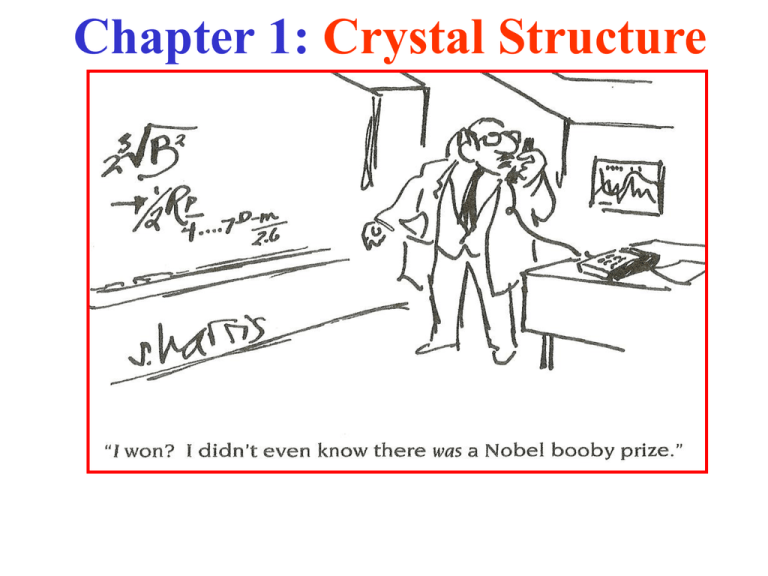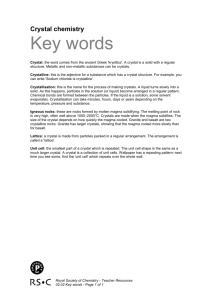Part I
advertisement

Chapter 1: Crystal Structure Chapter 1: Crystal Structure The Nobel “Booby” Prize! See the “Ig Nobel” Prize discussed at: http://improbable.com/ig/ The (Common) Phases of Matter Matter Gases Liquids & Liquid Crystals Solids This doesn’t include Plasmas, but these are the “common” phases!! “Condensed Matter” includes both of these. We’ll focus on Solids! Gases • Gases have atoms or molecules that do not bond to one another in a range of pressure, temperature & volume. Also, these molecules have no particular order & they move freely within a container. Liquids & Liquid Crystals • Similar to gases, Liquids have no atomic or molecular order & they assume the shape of their containers. • Applying low levels of thermal energy can easily break the existing weak bonds. • Liquid Crystals have mobile molecules, but a type of long range order can exist; the molecules have a permanent dipole. Applying an electric field rotates the dipole & establishes order within the collection of molecules. 5 Solids • Solids consist of atoms or molecules undergoing thermal motion about their equilibrium positions, which are at fixed points in space. • Solids can be crystalline, polycrystalline, or amorphous. • Solids (at a given temperature, pressure, volume) have stronger interatomic bonds than liquids. • So, Solids require more energy to break the interatomic bonds than liquids. Crystal Structure Topics 1. Periodic Arrays of Atoms 2. Fundamental Types of Lattices 3. Index System for Crystal Planes 4. Simple Crystal Structures 5. Direct Imaging of Crystal Structure 6. Non-ideal Crystal Structures 7. Crystal Structure Data Objectives At the end of this Chapter, you should: 1. Be able to identify a unit cell in a symmetrical pattern. 2. Know that (in 3 dimensions) there are 7 (& ONLY 7!!) Possible unit cell shapes. 3. Be able to define cubic, tetragonal, orthorhombic & hexagonal unit cell shapes Periodic Arrays of Atoms Experimental Evidence of periodic structures. (See Kittel, Fig. 1.) The external appearance of crystals gives some clues to this. Fig. 1 shows that when a crystal is cleaved, we can see that it is built up of identical “building blocks”. Further, the early crystallographers noted that the index numbers that define plane orientations are exact integers. Cleaving a Crystal Elementary Crystallography Solid Material Types Crystalline Single Crystals Polycrystalline Amorphous Crystals are Everywhere! More Crystals Early ideas • Crystals are solid - but solids are not necessarily crystalline • Crystals have symmetry (Kepler!!!) and long range order • Spheres and small shapes can be packed to produce regular shapes (Hooke, Hauy) The Three General Types of Solids Single Crystal, Polycrystalline, Amorphous •Each type is characterized by the size of the ordered region within the material. An ordered region is a spatial volume in which atoms or molecules have a regular geometric arrangement or periodicity. All Solids! • All solids have “resistance” to changes in both shape and volume • Solids can be Crystalline or Amorphous • Crystals are solids that consist of a periodic array of atoms, ions, or molecules – If this periodicity is preserved over “large” (macroscopic) distances the solid has “Longrange Order” • Amorphous solids do not have LongRange Order – Short Range Order Solids • Crystals: – Short-range Order – Long-range Order • Amorphous solids: – ~Short-range Order – No Long-range Order Solids • Different solids can have the same geometrical arrangements of atoms – Properties are determined by crystal structure, i.e. both crystal lattice and basis are important • Examples: – Si, Diamond (C), GaAs, ZnSe have the same geometry – Si and C (Diamond) Form “Diamond Structure” – GaAs or ZnSe form a structure called “Zinc Blende” Solids • Different arrangements of atoms (even the same atoms) give different properties Single layer is graphene Crystalline Solids • A Crystalline Solid is the solid form of a substance in which the atoms or molecules are arranged in a definite, repeating pattern in three dimensions. • Single Crystals, ideally have a high degree of order, or regular geometric periodicity, throughout the entire volume of the material. • A Single Crystal has an atomic structure that repeats periodically across its whole volume. Even at infinite length scales, each atom is related to every other equivalent atom in the structure by translational symmetry. Single Crystals Single Pyrite Amorphous Solid Crystal Polycrystalline Solids • A Polycrystalline Solid is made up of an aggregate of many small single crystals (crystallites or grains). Polycrystalline materials have a high degree of order over many atomic or molecular dimensions. These ordered regions, or single crystal regions, vary in size & orientation with respect to one another. These regions are called grains (or domains) & are separated from one another by grain boundaries. Polycrystalline Pyrite Grain Polycrystalline Solids • In Polycrystalline Solids, the atomic order can vary from one domain to the next. The grains are usually 100 nm - 100 microns in diameter. Polycrystals with grains that are < 10 nm in diameter are called nanocrystallites. Polycrystalline Pyrite Grain Amorphous Solids • Amorphous (Non-crystalline) Solids are composed of randomly orientated atoms, ions, or molecules that do not form defined patterns or lattice structures. Amorphous materials have order only within a few atomic or molecular dimensions. They do not have any long-range order, but they have varying degrees of short-range order. Examples of amorphous material include amorphous silicon, plastics, & glasses. Crystals • The periodic array of atoms, ions, or molecules that form the solid is called Crystal Structure Crystal Structure = Space (Crystal) Lattice + Basis – Space (Crystal) Lattice is a regular periodic arrangement of points in space, and is purely mathematical abstraction – Crystal Structure is formed by “putting” the identical atoms (group of atoms) in the points of the space lattice – This group of atoms is the Basis Departures From the “Perfect Crystal” • A “Perfect Crystal” is an idealization that does not exist in nature. In some ways, even a crystal surface is an imperfection, because the periodicity is interrupted there. • Each atom undergoes thermal vibrations around their equilibrium positions for temperatures T > 0K. These can also be viewed as “imperfections”. • Real Crystals always have foreign atoms (impurities), missing atoms (vacancies), & atoms in between lattice sites (interstitials) where they should not be. Each of these spoils the perfect crystal structure. Crystallography Crystallography ≡ The branch of science that deals with the geometric description of crystals & their internal arrangements. It is the science of crystals & the math used to describe them. It is a VERY OLD field which pre-dates Solid State Physics by about a century! So (unfortunately, in some ways) much of the terminology (& theory notation) of Solid State Physics originated in crystallography. The purpose of Ch. 1 of Kittel’s book is mainly to introduce this terminology to you. Solid State Physics Started in the early 20th Century when the fact that Crystals Can Diffract X-rays was discovered. •Around that same time the new theory of Quantum Mechanics was being accepted & applied to various problems. Some of the early problems it was applied to were the explanation of observed X-ray diffraction patterns for various crystals & (later) the behavior of electrons in a crystalline solid. Crystallography A Basic Knowledge of Elementary Crystallography is Essential for Solid State Physicists!!! • A crystal’s symmetry has a profound influence on many of its properties. • A crystal structure should be specified completely, concisely & unambiguously. • Structures are classified into different types according to the symmetries they possess. • In this course, we only consider solids with “simple” structures. Crystal Lattice Crystallography focuses on the geometric properties of crystals. So, we imagine each atom replaced by a mathematical point at the equilibrium position of that atom. A Crystal Lattice (or a Crystal) ≡ An idealized description of the geometry of a crystalline material. A Crystal ≡ A 3-dimensional periodic array of atoms. Usually, we’ll only consider ideal crystals. “Ideal” means one with no defects, as already mentioned. That is, no missing atoms, no atoms off of the lattice sites where we expect them to be, no impurities,…Clearly, such an ideal crystal never occurs in nature. Yet, 85-90% of experimental observations on crystalline materials is accounted for by considering only ideal crystals! Platinum Surface Platinum (Scanning Tunneling Microscope) Crystal Lattice Structure of Platinum Crystal Lattice Mathematically 2 Dimensional Example A Lattice is Defined as an Infinite Array of Points in Space in which each point has identical surroundings to all others. The points are arranged exactly in a periodic manner. y B α b C D A O a x E Ideal Crystal ≡ An infinite periodic repetition of identical structural units in space. • The simplest structural unit we can imagine is a Single Atom. This corresponds to a solid made up of only one kind of atom ≡ An Elemental Solid. • However, this structural unit could also be a group of several atoms or even molecules. The simplest structural unit for a given solid is called the BASIS • The structure of an Ideal Crystal can be described in terms of a mathematical construction called a Lattice. A Lattice ≡ • A 3-dimensional periodic array of points in space. For a particular solid, the smallest structural unit, which when repeated for every point in the lattice is called the Basis. • The Crystal Structure is defined once both the lattice & the basis are specified. That is Crystal Structure ≡ Lattice + Basis Crystals Crystal Structure = Space Lattice + Basis Crystalline Periodicity • In a crystalline material, the equilibrium positions of all the atoms form a crystal Crystal Structure ≡ Lattice + Basis For example, see Fig. Lattice 2 Atom Basis Crystal Structure Crystalline Periodicity Crystal Structure ≡ Lattice + Basis For another example, see the figure. Crystal Structure Lattice Basis Crystalline Periodicity Crystal Structure ≡ Lattice + Basis For another example, see the figure. Basis Crystal Structure Lattice A Two-Dimensional (Bravais) Lattice with Different Choices for the Basis 2 Dimensional Lattice Lattice with atoms at the corners of regular yhexagons y B C α b B C F O a E D E b D G A x O a A x H 38 The atoms do not necessarily lie at lattice points!! Crystal Structure = Lattice + Basis Basis Crystal Structure 39






